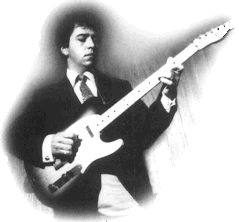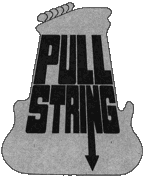Putting pedal steel licks in the hands of guitarists
The History of the Third Hand |
 GENE SEZ: "Clarence White's musical ideas created the need for a B-Bender and being raised in my Dad's machine shop gave me the skills to figure out how to meet that need. Clarence was exploring the musical possibilities of bending notes on a Telecaster. Late in 1965 Clarence and I were playing on a lot of recording sessions together. We had finished the basic tracks on a tune, maybe a Rex and Vern Gosdin track. Clarence was ready to put the lead guitar track on when he realized he needed three hands for the lick he had in mind."
GENE SEZ: "Clarence White's musical ideas created the need for a B-Bender and being raised in my Dad's machine shop gave me the skills to figure out how to meet that need. Clarence was exploring the musical possibilities of bending notes on a Telecaster. Late in 1965 Clarence and I were playing on a lot of recording sessions together. We had finished the basic tracks on a tune, maybe a Rex and Vern Gosdin track. Clarence was ready to put the lead guitar track on when he realized he needed three hands for the lick he had in mind.""One of Clarence's innovative guitar techniques was to chime the high E or B string and bend it up a full tone by pulling the string down above the nut. This worked great in open position but on this particular tune he wanted to play the lick up the neck. He needed another hand to do it. I provided the third hand on that occasion. It was a great sounding lick although having both of us play one guitar wasn't going to work for live performances. We were both intrigued by the musical possibilities of having a third hand to play guitar."  "I knew there had to be a way for Clarence to bend the string himself. I offered to install pedals and cables like those used on pedal steel guitars. Clarence refused because he wanted something that would fit inside his guitar case."
"I knew there had to be a way for Clarence to bend the string himself. I offered to install pedals and cables like those used on pedal steel guitars. Clarence refused because he wanted something that would fit inside his guitar case.""After a couple of weeks of thinking about it, I came up with the idea of using the shoulder strap to actuate a string-pulling, note-bending mechanism. Not only would it fit into the guitar case, it would actually go inside the guitar! I drew up some plans that incorporated a steel guitar bridge that Sneaky Pete Kleinow procured for me. After a little convincing Clarence bravely agreed to let me install this contraption in his beloved Telecaster. He said, "Just don't show me until it's done." "I wasn't certain at first which strings to pull or drop or whether to affect two strings at once. We tried all kinds of stuff, including using an armrest as well as the shoulder strap, to do all kinds of things to the first four strings. Clarence found that all he really wanted was to be able to bend the B string a whole step using his shoulder strap. He found a whole new world of guitar licks using a B-Bender." |
 B-Bender and The Byrds
B-Bender and The Byrds Clarence and Gene joined The Byrds in 1968. With help from Eddie Tickner who was managing the Byrds, they obtained a patent on their string-bending mechanism. They brought the design to Leo Fender who arranged for Fender/CBS to license the right to manufacture the design. After the new management at Fender let the patent license expire without ever getting the B-Bender into production, Leo left Fender. Clarence White was killed by a drunk driver in 1973. His Telecaster, with the prototype Bender, now belongs to Marty Stuart.
Clarence and Gene joined The Byrds in 1968. With help from Eddie Tickner who was managing the Byrds, they obtained a patent on their string-bending mechanism. They brought the design to Leo Fender who arranged for Fender/CBS to license the right to manufacture the design. After the new management at Fender let the patent license expire without ever getting the B-Bender into production, Leo left Fender. Clarence White was killed by a drunk driver in 1973. His Telecaster, with the prototype Bender, now belongs to Marty Stuart.

 Although Gene has upgraded the design for ease of manufacturing and installation the basic geometry has stayed the same. Gene says, "I experimented with smaller, less complicated mechanisms that would entail less routing. I found that in order for the StringBender to work smoothly, evenly, stay in tune, and have an extremely musical action, a large bearing surface and return spring were required."
Although Gene has upgraded the design for ease of manufacturing and installation the basic geometry has stayed the same. Gene says, "I experimented with smaller, less complicated mechanisms that would entail less routing. I found that in order for the StringBender to work smoothly, evenly, stay in tune, and have an extremely musical action, a large bearing surface and return spring were required."